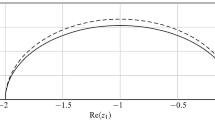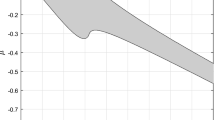Abstract
We investigate implicit–explicit (IMEX) general linear methods (GLMs) with inherent Runge–Kutta stability (IRKS) for differential systems with non-stiff and stiff processes. The construction of such formulas starts with implicit GLMs with IRKS which are A- and L-stable, and then we ‘remove’ implicitness in non-stiff terms by extrapolating unknown stage derivatives by stage derivatives which are already computed by the method. Then we search for IMEX schemes with large regions of absolute stability of the ‘explicit part’ of the method assuming that the ‘implicit part’ of the scheme is \(A(\alpha )\)-stable for some \(\alpha \in (0,\pi /2]\). Examples of highly stable IMEX GLMs are provided of order \(1\le p\le 4\). Numerical examples are also given which illustrate good performance of these schemes.
























Similar content being viewed by others
References
Abdulle, A., Vilmart, G.: PIROCK: a swiss-knife partitioned implicit–explicit orthogonal Runge–Kutta–Chebyshev integrator for stiff diffusion–advection–reaction problems with or without noise. J. Comput. Phys. 242, 869–888 (2013)
Ascher, U.M., Ruuth, S.J., Spiteri, R.J.: Implicit–explicit Runge–Kutta methods for time-dependent partial differential equations. Appl. Numer. Math. 25, 151–167 (1997)
Ascher, U.M., Ruuth, S.J., Wetton, B.: Implicit–explicit methods for time dependent PDE’s. SIAM J. Numer. Anal. 32, 797–823 (1995)
Beck, S., Weiner, R., Podhaisky, H., Schmitt, B.A.: Implicit peer methods for large stiff ODE systems. J. Appl. Math. Comput. 38, 389–406 (2012)
Boscarino, S.: Error analysis of IMEX Runge–Kutta methods derived from differential–algebraic systems. SIAM J. Numer. Anal. 45, 1600–1621 (2007)
Boscarino, S.: On the accurate third order implicit–explicit Runge–Kutta methods for stiff problems. Appl. Numer. Math. 59, 1515–1528.37 (2009), B305–B331 (2015)
Boscarino, S., Bürger, R., Mulet, P., Russo, G., Villada, M.L.: Linearly implicit IMEX Runge–Kutta methods for a class of degenerate convection–diffusion problems. SIAM J. Sci. Comput. 37, B305–B331 (2015). doi:10.1137/140967544
Boscarino, S., Russo, G.: On a class of uniformly accurate IMEX Runge–Kutta schemes and applications to hyperbolic systems with relaxation. SIAM J. Sci. Comput. 31, 1926–1945 (2009)
Braś, M., Cardone, A., Jackiewicz, Z., Welfert, B.: Order reduction phenomenon for general linear methods. SIAM J. Number. Anal. (submitted)
Butcher, J.C.: The Numerical Analysis of Ordinary Differential Equations. Runge–Kutta and General Linear Methods. Wiley, Chichester (1987)
Butcher, J.C.: Diagonally-implicit multi-stage integration methods. Appl. Numer. Math. 11, 347–363 (1993)
Butcher, J.C.: Numerical Methods for Ordinary Differential Equations. Wiley, Chichester (2003)
Butcher, J.C.: General linear methods. Acta Numer. 15, 157–256 (2006)
Butcher, J.C., Jackiewicz, Z.: Diagonally implicit general linear methods for ordinary differential equations. BIT 33, 452–472 (1993)
Butcher, J.C., Jackiewicz, Z.: Construction of general linear methods with Runge–Kutta stability properties. Numer. Algorithms 36, 53–72 (2004)
Butcher, J.C., Jackiewicz, Z., Wright, W.M.: Error propagation for general linear methods for ordinary differential equations. J. Complex. 23, 560–580 (2007)
Butcher, J.C., Wright, W.M.: The construction of practical general linear methods. BIT 43, 695–721 (2003)
Calvo, M.P., de Frutos, J., Novo, J.: Linearly implicit Runge–Kutta methods for advection–diffusion–reaction problems. Appl. Numer. Math. 37, 535–549 (2001)
Cardone, A., Jackiewicz, Z., Sandu, A., Zhang, H.: Extrapolation-based implicit–explicit general linear methods (2013), arXiv:1304.2276
Cardone, A., Jackiewicz, Z., Sandu, A., Zhang, H.: Extrapolation-based implicit–explicit general linear methods. Numer. Algorithms 65, 377–399 (2014)
Cardone, A., Jackiewicz, Z., Sandu, A., Zhang, H.: Extrapolated implicit–explicit Runge–Kutta methods. Math. Model. Anal. 19, 18–43 (2014)
Cardone, A., Jackiewicz, Z., Sandu, A., Zhang, H.: Construction of highly stable implicit-explicit general linear methods. In: Discrete and Continuous Dynamical Systems. Series S, vol. 2015, pp. 185–194 (2015)
Crouzeix, M.: Une méthode multipas implicite-explicite pour l’approximation des équations d’évolution paraboliques. Numer. Math. 35, 257–276 (1980)
Dym, H., McKean, H.P.: Fourier Series and Integrals. Academic Press, New York (1972)
Frank, J., Hundsdorfer, W., Verwer, J.G.: On the stability of implicit–explicit linear multistep methods. Appl. Numer. Math. 25, 193–205 (1997)
Hairer, E., Nørsett, S.P., Wanner, G.: Solving Ordinary Differential Equations I: Nonstiff Problems. Springer, New York (1993)
Hairer, E., Wanner, G.: Solving Ordinary Differential Equations II. Stiff and Differential–Algebraic Problems. Springer, Berlin (1996)
Hundsdorfer, W., Ruuth, S.J.: IMEX extensions of linear multistep methods with general monotonicity and boundedness properties. J. Comput. Phys. 225, 2016–2042 (2007)
Hundsdorfer, W., Verwer, J.G.: Numerical Solution of Time-Dependent Advection–Diffusion–Reaction Equations. Springer, Berlin, Heidelberg, New York (2003)
Izzo, G., Jackiewicz, Z.: Highly stable implicit–explicit Runge–Kutta methods. Appl. Number. Math. (submitted)
Jackiewicz, Z.: Implementation of DIMSIMs for stiff differential systems. Appl. Numer. Math. 42, 251–267 (2002)
Jackiewicz, Z.: Construction and implementation of general linear methods for ordinary differential equations. A review. J. Sci. Comput. 25, 29–49 (2005)
Jackiewicz, Z.: General Linear Methods for Ordinary Differential Equations. Wiley, Hoboken (2009)
Jebens, S., Knoth, O., Weiner, R.: Partially implicit peer methods for the compressible Euler equations. J. Comput. Phys. 230, 4955–4974 (2011)
Kennedy, C.A., Carpenter, M.H.: Additive Runge–Kutta schemes for convection–diffusion–reaction equations. Appl. Numer. Math. 44, 139–181 (2003)
Layton, A.T., Minion, M.L.: Implications of the choice of quadrature nodes for Picard integral deferred correction methods for ordinary differential equations. BIT 45, 341–373 (2005)
Minion, M.L.: Semi-implicit projection methods for incompressible flow based on spectral deferred corrections. Appl. Numer. Math. 48, 369–387 (2004)
Pareschi, L., Russo, G.: Implicit–explicit Runge–Kutta schemes for stiff systems of differential equations. Recent trends in numerical analysis, 269–288, Adv. Theory Comput. Math., 3, Nova Science Publishers, Huntington, NY (2001)
Pareschi, L., Russo, G.: Implicit–explicit Runge–Kutta schemes and applications to hyperbolic systems with relaxation. J. Sci. Comput. 25, 129–155 (2005)
Pearson, J.E.: Complex patterns in a simple systems. Science 261, 189–192 (1993)
Prothero, A., Robinson, A.: On the stability and accuracy of one-step methods for solving stiff systems of ordinary differential equations. Math. Comput. 28, 145–162 (1974)
Shampine, L.F., Sommeijer, B.P., Verwer, J.G.: IRKC: an IMEX solver for stiff diffusion–reaction PDEs. J. Comput. Appl. Math. 196, 485–497 (2006)
Schnakenberg, J.: Simple chemical reaction systems with limiting cycle behaviour. J. Theor. Biol. 81, 389–400 (1979)
Shu, C.-W.: High order ENO and WENO schemes for computational fluid dynamics. In: Barth, T.J., Deconinck, H. (eds.) High-Order Methods for Computational Physics. Lecture Notes in Computational Science and Engineering, vol. 9, pp. 439–582. Springer, Berlin (1999)
Wang, R., Spiteri, R.J.: Linear instability of the fifth-order WENO method. SIAM J. Numer. Anal. 45, 1871–1901 (2007)
Wright, W.: General linear methods with inherent Runge–Kutta stability, Ph.D. thesis, The University of Auckland, New Zealand (2002)
Wright, W.: Explicit general linear methods with inherent Runge–Kutta stability. Numer. Algorithms 31, 381–399 (2002)
Zeeman, E.C.: Differential Equations for the Heartbeat and Nerve Impulse. In: Waddington, C.H. (ed.) Towards a Theoretical Biology, vol. 4, pp. 4–67. Edinburgh University Press, Edinburgh (1972)
Zhang, H., Sandu, A., Blaise, S.: High order implicit–explicit general linear methods with optimized stability regions (2014), arXiv:1407.2337
Zhang, H., Sandu, A., Blaise, S.: Partitioned and implicit–explicit general linear methods for ordinary differential equations. J. Sci. Comput. 61, 119–144 (2014)
Zharovsky, E., Sandu, A., Zhang, H.: A class of implicit–explicit two-step Runge–Kutta methods. SIAM J. Numer. Anal. 53, 321–341 (2015)
Acknowledgments
The research reported in this paper was started during the visit of the first author (MB) to the Arizona State University in November 2014. This author wish to express his gratitude to the School of Mathematical and Statistical Sciences for hospitality during this visit.
Author information
Authors and Affiliations
Corresponding author
Additional information
The work of Michał Braś was supported by the National Science Center under Grant DEC-2011/01/N/ST1/02672 and the Polish Ministry of Science and Higher Education.
The work of Giuseppe Izzo was partially supported by GNCS-INdAM.
Rights and permissions
About this article
Cite this article
Braś, M., Izzo, G. & Jackiewicz, Z. Accurate Implicit–Explicit General Linear Methods with Inherent Runge–Kutta Stability. J Sci Comput 70, 1105–1143 (2017). https://doi.org/10.1007/s10915-016-0273-y
Received:
Revised:
Accepted:
Published:
Issue Date:
DOI: https://doi.org/10.1007/s10915-016-0273-y




